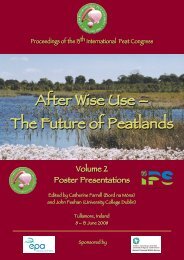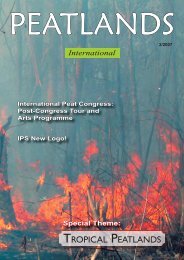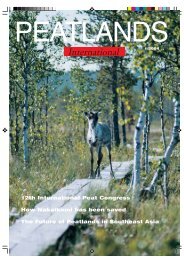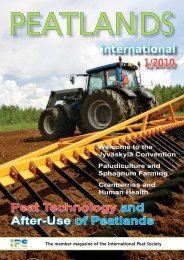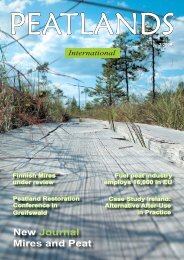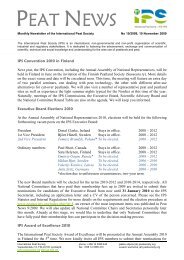peatlands 1 taitto.indd - International Peat Society
peatlands 1 taitto.indd - International Peat Society
peatlands 1 taitto.indd - International Peat Society
Create successful ePaper yourself
Turn your PDF publications into a flip-book with our unique Google optimized e-Paper software.
Fig 5: High coverages of Purple Moorgras and sedges in a dense<br />
carpet of peat mosses.<br />
The warm-temperate climate of the<br />
Kolkheti lowland seems to enable the<br />
thermophilic species to cope with acid<br />
and nutrient poor conditions naturally.<br />
But also human impact like frequent<br />
burning may have enhanced Saw grass.<br />
Human impact is also refl ected in the<br />
peat stratigraphy in the uppermost 0.2<br />
- 0.5 m, in which remnants of Purple<br />
moor grass prevail. Also the absence<br />
of Sphagnum imbricatum, a fi re-sensitive<br />
species that was still abundant in the<br />
1930s (Dokturovski 1936), points in<br />
the same direction.<br />
Hydrology<br />
With respect to hydrological characteristics,<br />
Imnati shows an average phreatic<br />
water level of -8 cm below the mire<br />
surface and water table fl uctuations<br />
of less than 14 cm in average. The hydraulic<br />
conductivity of the peat (also at<br />
greater depths) has values 0.1 – 5 md -1<br />
higher than in other bogs worldwide.<br />
The hydraulic conductivity changes<br />
little over depth, with a decrease of<br />
generally only one order of magnitude<br />
from 0.4 – 3.9 m. This enables water<br />
to fl ow through the whole bog peat<br />
body (Lamme 2006). The high hy-<br />
draulic conductivity<br />
of the porous peat<br />
prevents surface run<br />
off in periods with<br />
high precipitation<br />
and leads to better<br />
nutrient availability<br />
through water fl ow<br />
(rheotrophy sensu<br />
Kulczyński 1949).<br />
On the other hand<br />
it would cause a<br />
running dry of the<br />
mire in dry periods<br />
that frequently occur<br />
in summer and<br />
may last for several<br />
weeks. Desiccation,<br />
however, does not<br />
happen because of<br />
the high elasticity of<br />
the peat that results<br />
from its high root<br />
content and the low<br />
humifi cation, which<br />
provide a good<br />
oscillation capacity<br />
of the mire surface. The mire surface<br />
sinks with the phreatic water level in<br />
dry periods and rises in periods of high<br />
rainfall (mire oscillation – “Mooratmung”).<br />
<strong>Peat</strong>, vegetation and water<br />
<strong>Peat</strong>, vegetation, and water<br />
are in a steady state in Imnati<br />
today. The abnormally<br />
high proportion of vascular<br />
plants for Sphagnum<br />
bogs induces higher evapotranspiration<br />
rates and<br />
a consequent larger water<br />
table drop down, resulting<br />
in higher rates of decomposition,<br />
which destroy the<br />
pore space and elasticity<br />
of the peat. This again<br />
would increase the water<br />
table fl uctuations. Extended<br />
periods of desiccation<br />
would hamper peat moss<br />
growth and would stimulate<br />
nutrient availability<br />
through decomposition,<br />
which would further boost<br />
the share of vascular<br />
plants (positive feedback<br />
loop). In Imnati, however, the vascular<br />
plants provide a “skeleton” for peat<br />
mosses whose extraordinary growth<br />
rates in this region (Krebs & Gaudig<br />
2005) prevent them from being outcompeted<br />
by vascular plants. As a<br />
result, highly porous and elastic peat<br />
accumulates, whose high storage and<br />
oscillation capacity stops the escalation<br />
of the positive feedback loop.<br />
Imnati is an impressive example that<br />
percolation bogs have resilience against<br />
irregular precipitation. The oscillation<br />
capacity is the decisive mechanism<br />
that helps this mire type to bridge dry<br />
periods “actively”. The high hydraulic<br />
conductivity of the peat avoids a<br />
drowning in wet periods “passively”.<br />
Utilisation of the peatland<br />
Mire utilisation only started 150 years<br />
ago with the cutting of marginal forests.<br />
In 1935, peat excavation started in<br />
the southern part of the mire, where<br />
it continued into the 1980s. The peat<br />
was mixed with phosphorus and other<br />
mineral fertilisers to be used for soil<br />
improvement in tea and citrus plantations<br />
(Tabadze 1963). Also the production<br />
of fuel pellets was tried out in<br />
1955/56. Their quality was, however,<br />
worse than from other <strong>peatlands</strong> in the<br />
Fig 6: Typical aspect in the vegetation in Imnati - Yellow<br />
Azaleas fl owering in spring.<br />
37



